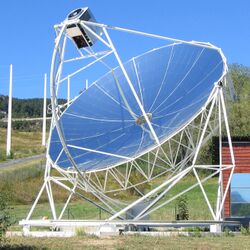Solar-powered Stirling engine
Topic: Engineering
 From HandWiki - Reading time: 3 min
From HandWiki - Reading time: 3 min
A solar powered Stirling engine is a heat engine powered by a temperature gradient generated by the sun. Even though Stirling engines can run with a small temperature gradient, it is more efficient to use concentrated solar power.
The mechanical output can be used directly (e.g. pumps) or be used to create electricity.
NASA
NASA patented a type of solar-powered Stirling engine on August 3, 1976. It used solar energy to pump water from a river, lake, or stream.[1] The purpose of this apparatus is to “provide a low-cost, low-technology pump having particular utility in irrigation systems employed in underdeveloped arid regions of the earth…[using] the basic principles of the Stirling heat engine“.[1]
Meijer
One design was patented by Roelf J. Meijer in 1987.[2] His invention combines a heat engine, such as a Stirling cycle engine, with a solar dish collector to produce electricity.[2] This apparatus consists of a large dish that concentrates solar energy to a focal point at the center of the dish. The concentrated solar energy drives Stirling cycle engine,[2] which operates by letting heat flow from a hot source to a cold sink to do work.[3] The work output of the Stirling cycle then drives a generator to create electric power. Moreover, for optimal heat collection, Meijer’s solar-powered engine requires that the dish always point directly at the sun so no shadows are in the solar dish collector. This presented issues because, for the apparatus to have a complete range of motion, lubrication and rotational systems are necessary, and may compromise structural stability.[2]
Sunvention
Around 2010, a company called Sunvention Solar Energy created a device similar to the NASA design that they say can pump 100,000 gallons per day, purely off of solar energy and the Stirling cycle, and costing only US$1,250. This apparatus, much like the others, used a large solar dish to collect heat from the sun to create a high temperature source, and also used low temperature water from a nearby stream as its low temperature source. This provided a great temperature range, which in turn provided more power. The apparatus pumped the water into nearby crop fields, providing a “low-cost, low-technology pump having particular utility in irrigation systems employed in underdeveloped arid regions of the earth.”
Comparison to Solar Panels
Solar-powered Stirling engines are in some situations more efficient in generating electrical energy than solar panels.[4] Thermal capacity and rotating mass result in less sudden changes in output power. Experiments show the possibility of higher efficiencies.[5]
Solar-powered Stirling engines are less scalable than solar panels. They are also more complex than a solar-electric system.
Solar-powered Stirling engines can have a secondary heat source (e.g. Gas), allowing operation during night and when the sky is clouded.
See also
References
- ↑ 1.0 1.1 Fletcher, James C. & Charles C. Kirsten, "Solar-powered pump", US patent 3972651, published 1976-08-03
- ↑ 2.0 2.1 2.2 2.3 Meijer, Roelf J., "Solar-powered Stirling engine", US patent 4707990, published 1987-11-24, assigned to Stirling Thermal Motors Inc.
- ↑ Moran, Michael (2011), Fundamentals of Engineering Thermodynamics, Hoboken NJ, pp. 72–73
- ↑ "Envirodish - Promes". http://www.promes.cnrs.fr/index.php?page=envirodish.
- ↑ "Stirlingmotor beflügelt Solarkraftwerke". 28 January 2010. https://www.heise.de/newsticker/meldung/Stirlingmotor-befluegelt-Solarkraftwerke-916656.html.
External links
 |
 KSF
KSF
